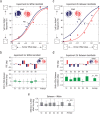Unifying Visual Space Across the Left and Right Hemifields
- PMID: 29346029
- PMCID: PMC6053023
- DOI: 10.1177/0956797617735534
Unifying Visual Space Across the Left and Right Hemifields
Abstract
Visual space is perceived as continuous and stable even though visual inputs from the left and right visual fields are initially processed separately within the two cortical hemispheres. In the research reported here, we examined whether the visual system utilizes a dynamic recalibration mechanism to integrate these representations and to maintain alignment across the visual fields. Subjects adapted to randomly oriented moving lines that straddled the vertical meridian; these lines were vertically offset between the left and right hemifields. Subsequent vernier alignment judgments revealed a negative aftereffect: An offset in the same direction as the adaptation was required to correct the perceived misalignment. This aftereffect was specific to adaptation to vertical, but not horizontal, misalignments and also occurred following adaptation to movie clips and patterns without coherent motion. Our results demonstrate that the visual system unifies the left and right halves of visual space by continuously recalibrating the alignment of elements across the visual fields.
Keywords: adaptation; hemifield; open data; open materials; perceptual continuity; psychophysics; visual fields; visual perception.
Conflict of interest statement
Figures






Similar articles
-
Dynamic distractor environments reveal classic visual field anisotropies for judgments of temporal order.Atten Percept Psychophys. 2019 Apr;81(3):738-751. doi: 10.3758/s13414-018-1628-2. Atten Percept Psychophys. 2019. PMID: 30520009
-
Motor space structures perceptual space: evidence from human saccadic adaptation.Brain Res. 2007 Oct 3;1172:32-9. doi: 10.1016/j.brainres.2007.07.040. Epub 2007 Aug 3. Brain Res. 2007. PMID: 17803970
-
Sustained Splits of Attention within versus across Visual Hemifields Produce Distinct Spatial Gain Profiles.J Cogn Neurosci. 2016 Jan;28(1):111-24. doi: 10.1162/jocn_a_00883. Epub 2015 Sep 24. J Cogn Neurosci. 2016. PMID: 26401813
-
Adaptation to a spatial offset occurs independently of the flash-drag effect.J Vis. 2013 Feb 6;13(2):7. doi: 10.1167/13.2.7. J Vis. 2013. PMID: 23390321
-
Perceptual learning transfer between hemispheres and tasks for easy and hard feature search conditions.J Vis. 2011 Jan 7;11(1):8. doi: 10.1167/11.1.8. J Vis. 2011. PMID: 21216770
Cited by
-
Functional localization of the human auditory and visual thalamus using a thalamic localizer functional magnetic resonance imaging task.Imaging Neurosci (Camb). 2024 Nov 12;2:imag-2-00360. doi: 10.1162/imag_a_00360. eCollection 2024. Imaging Neurosci (Camb). 2024. PMID: 40800539 Free PMC article.
-
An enhanced role for right hV5/MT+ in the analysis of motion in the contra- and ipsi-lateral visual hemi-fields.Behav Brain Res. 2019 Oct 17;372:112060. doi: 10.1016/j.bbr.2019.112060. Epub 2019 Jun 25. Behav Brain Res. 2019. PMID: 31251957 Free PMC article.
-
Functional Localization of the Human Auditory and Visual Thalamus Using a Thalamic Localizer Functional Magnetic Resonance Imaging Task.bioRxiv [Preprint]. 2024 Oct 18:2024.04.28.591516. doi: 10.1101/2024.04.28.591516. bioRxiv. 2024. Update in: Imaging Neurosci (Camb). 2024 Nov 12;2:imag-2-00360. doi: 10.1162/imag_a_00360. PMID: 38746171 Free PMC article. Updated. Preprint.
References
-
- Ahumada A. J., Mulligan J. B. (1990). Learning receptor positions from imperfectly known motions. In Rogowitz B. E., Allebach J. P. (Eds.), Proceedings Volume 1249, Human vision and electronic imaging: Models, methods, and applications (pp. 124–134). Bellingham, WA: SPIE. doi:10.1117/12.19665 - DOI
-
- Brainard D. H. (1997). The Psychophysics Toolbox. Spatial Vision, 10, 433–436. - PubMed
-
- Efron B., Tibshirani R. J. (1993). An introduction to the bootstrap. London, England: Chapman & Hall.
Publication types
MeSH terms
Grants and funding
LinkOut - more resources
Full Text Sources
Other Literature Sources

